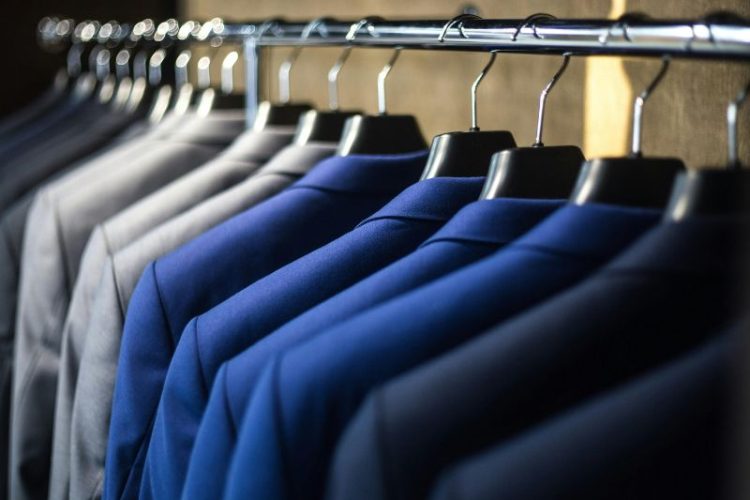Clothing made in Vietnam has become a familiar sight around the world. It’s not unusual to see “Made in Vietnam” on the tags of a Nike t-shirt, an H&M dress, or a Uniqlo jacket. That label is a sign of skilled work and reliable quality.
If you’re considering introducing clothing from Vietnam to your market but aren’t sure where to find reliable suppliers, which products to select, or what documents are required for shipping, this guide is for you. We’ll walk you through how to import clothing from Vietnam in a straightforward way, with practical tips you can actually use.
Overview of Vietnam’s Clothing Market
Vietnam has become one of the world’s key players in clothing and textiles, second only to China. In 2024, the country exported around 44 billion USD worth of apparel, with growth of over 11 percent from the year before.
The growth trend has continued into 2025. In the first half of the year, exports reached about 21.8 billion USD, more than 10 percent higher than the same period last year. The Vietnam Textile and Apparel Association expects full-year exports to rise further, possibly by another 9 percent above 2024.
Regarding key importers, the United States and the European Union are the biggest destinations. Asian markets such as Japan, South Korea and China also play a major role.
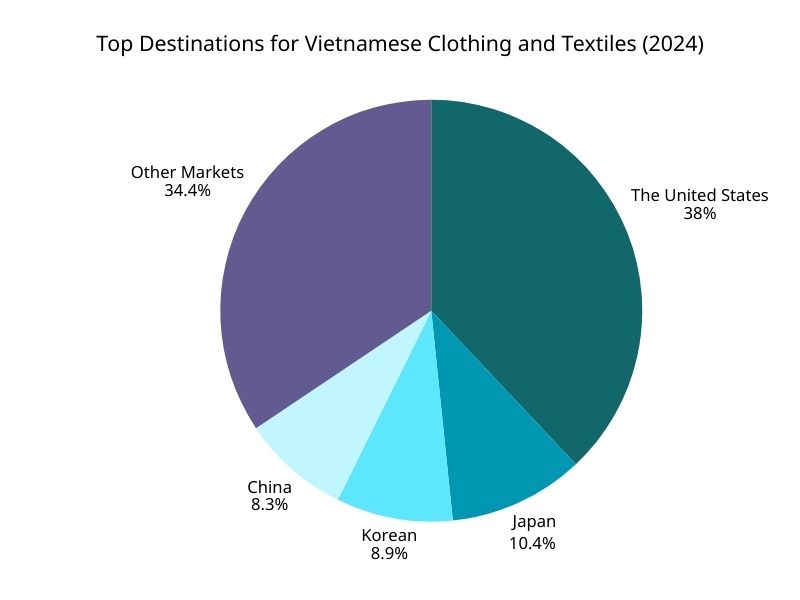
Why Import Clothing from Vietnam?
What really makes Vietnam a good choice for your sourcing plans comes down to a few clear advantages:
- Prices are very competitive. Labor costs here are usually about half of China’s and lower than places like Thailand or Malaysia.
- Vietnam’s workforce is both big and talented. More than three million people are employed in the industry, many of them women valued for their precision, which makes it easy for factories here to meet high-quality standards.
- Compliance and sustainability are another strength. Many leading manufacturers, such as Vinatex and Garco 10, already hold certifications like ISO, WRAP, BSCI, and OEKO-TEX, so you can be confident that products meet modern expectations for responsible sourcing. This makes Vietnam a safer bet than cheap “made-in-China” suppliers.
- Free trade agreements such as EVFTA, CPTPP, and RCEP make importing even easier. In many markets, including the EU, Japan, and Korea, tariffs are very low or even zero, and customs procedures are more straightforward.
Popular Types of Clothing to Import from Vietnam
Vietnamese suppliers are always adding more variety to what they offer. Jackets are at the top of the list with over 4.38 billion USD in export value, followed by trousers, shirts, and undergarments.
1. Jackets
Common materials: nylon, polyester, polyester blends, poly‑cotton, ripstop, softshell / waterproof membranes, denim
You’ll find everything from sporty windbreakers and casual everyday styles to weather-proof outerwear. Factories here are especially good at lightweight running jackets made from nylon or polyester that are water-resistant. Hoodies in cotton blends and classic denim jackets are also popular picks. It’s no surprise that global outdoor brands like Patagonia and The North Face already make jackets in Vietnam.
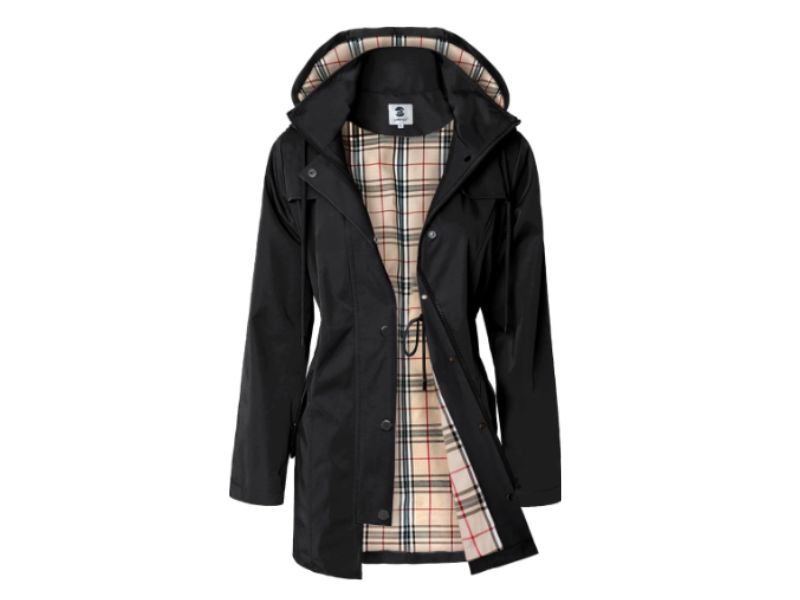
2. Pants and Trousers
Common materials: cotton twill, cotton chino, poly‑cotton blends, fleece (cotton/synthetic mix), stretch fabrics with spandex / elastane, denim
This is another big export group, worth nearly 3.9 billion USD. Chinos and khakis in soft cotton twill are a favorite for office wear, while jogger pants in fleece with a bit of stretch work well for casual and active use. Leggings for women are also in demand. Well-known names like Adidas and Lululemon are already sourcing pants from Vietnam.
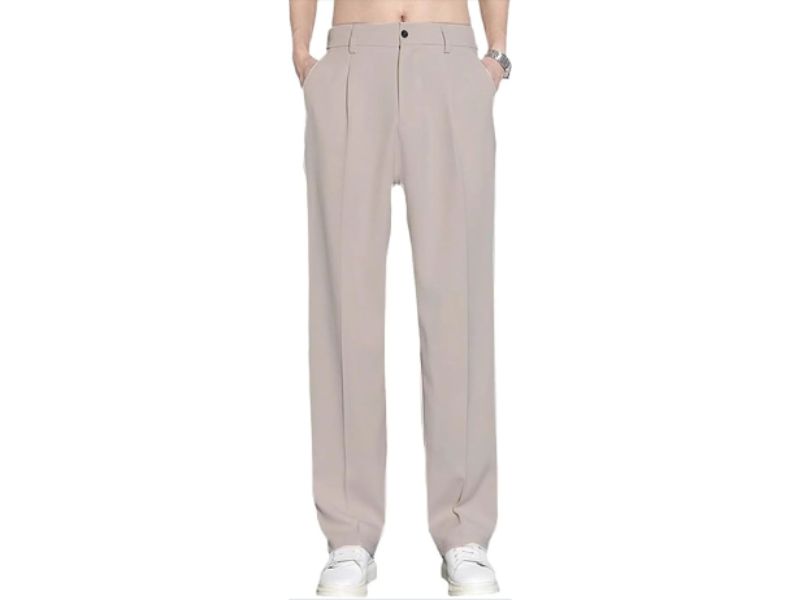
3. Shirts
Common materials: 100% cotton (jersey, poplin), cotton blends (cotton‑polyester), pique cotton, rayon / viscose, polyester, organic cotton
Vietnamese suppliers offer a wide mix of styles, from classic crew-neck t-shirts to cotton pique polos that work well for semi-casual wear. Many top manufacturers are also great partners for private-label projects, offering screen printing, sublimation, embroidery, and heat transfer. Big names like Under Armour and Tommy Hilfiger already source from the country.
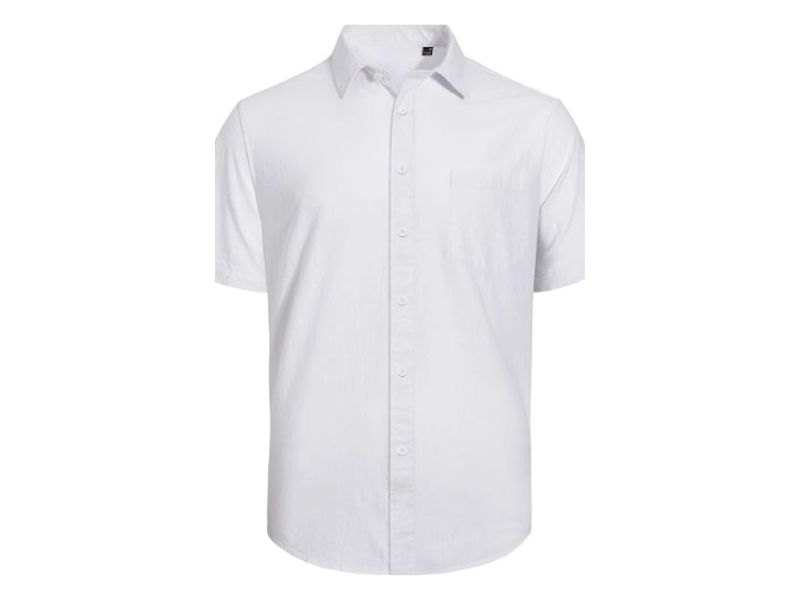
4. Undergarments
Common materials: cotton, modal, bamboo fabric, synthetic blends (nylon/spandex / poly‑elastane), lace, microfiber
At one point, Vietnam was the world’s third-largest exporter of men’s knitted underwear, with the US and Japan as major buyers. Classic cotton briefs are among the best-selling items. For women, factories make everything from everyday bras and panties to sports bras and delicate lingerie. Brands like Victoria’s Secret and Calvin Klein have both produced collections here.
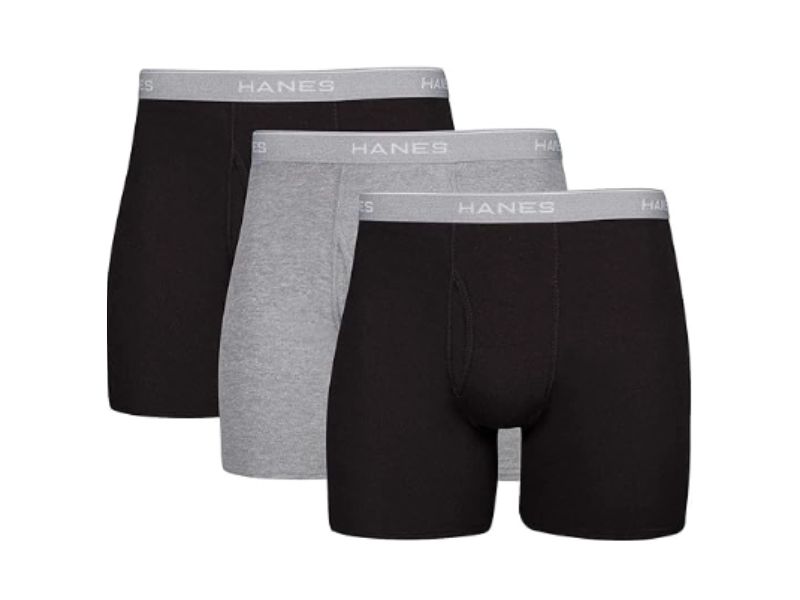
And it doesn’t stop there. Vietnam also supplies large volumes of specialized apparel like sportswear, activewear, and workwear, often produced under OEM and ODM arrangements for international brands.
Where to Find Clothing Suppliers in Vietnam?
If you’re thinking about how to import clothing from Vietnam, the next question is usually: where do you actually find the right exporters? Here are a few easy ways to start:
1. Visit Trade Shows & Exhibitions
These events bring together hundreds of clothing manufacturers under one roof. It’s a great chance to see products up close and sit down for real conversations about your needs. The only thing to remember is that these shows don’t always follow a set schedule, so you’ll want to keep an eye on the organizers’ updates.
Notable fairs for Vietnamese textiles & garment sourcing:
- Vietnam International Textile & Garment Industry Exhibition (VTG), held in Ho Chi Minh City
- SaigonTex, hosted annually at the Saigon Exhibition and Convention Center (SECC), Ho Chi Minh City
- VIATT Vietnam International Trade Fair for Apparel, Textiles and Textile Technologies, organized in Ho Chi Minh City by Messe Frankfurt and VIETRADE
- Vietnam HanoiTex, held at the Hanoi International Exhibition Center
2. Connect with Industry Networks & Associations
Groups like the Vietnam Textile and Apparel Association or the American Chamber of Commerce in Vietnam can point you toward suppliers that match your business. They’re also a useful source of advice on quality standards. Just note that they act more like a bridge; they can connect you, but it’s still up to you to check a factory’s capacity and reliability.
Some best clothing suppliers from Vietnam include:
- Thygesen Textile Vietnam: known for activewear, kidswear, workwear, and underwear with strong OEM and ODM capabilities.
- DONY Garment: specializes in uniforms, jackets, casualwear, and hats with private label support and competitive pricing.
- Phong Phu Corporation: a leading name in denim, knitwear, and full-package textile production from yarn to finished garments.
- Vinatex: Vietnam’s national textile group offering a wide range of woven and knit garments at large scale.
- Kiara Garments Vietnam: focused on women’s knit and woven apparel for export, with a solid ODM model.
3. Use Online B2B Platforms
This is the most convenient way if you want to explore suppliers without traveling. You can quickly compare product ranges, factory details, and certifications. Popular options include:
- Alibaba, an international B2B platform for B2B with many of listings from Vietnam clothing manufacturers
- Global Sources, a global B2B platform which focuses on verified manufacturers, including Vietnam
- VinaSources, a platform dedicated to trusted Vietnamese suppliers
The only downside is that not all online information is complete or confirmed. It’s always safer to choose platforms that screen suppliers carefully, and even better if they can support you through the whole export process.
How to Work with Vietnamese Clothing Suppliers
Once you’ve spotted a supplier that feels like a good fit, the next step is making sure you understand how they work, and just as important, that they understand what you’re looking for.
1. Talk about Prices, Payment Terms, and MOQs
Minimum order quantities (MOQs) for clothing items are often in the hundreds, sometimes up to 1,000 pieces per style and color. But for a first order, many Vietnamese factories are willing to be flexible, especially if they see long-term potential with your brand.
Production times can range from about 30 to 90 days, depending on the design, fabric, and time of year. One thing to keep in mind: factories close not only for the New Year but also for the Lunar New Year (Tet), which usually lasts more than a week in January. Things slow down a bit around then, so it’s smart to build in some extra time.
And here’s a quick snapshot:
| # | Main Category | Typical MOQ | Common Lead Time | FOB Price (USD) |
| 1 | Jackets and Outerwear | About 500 to 1000 pcs | 20 to 30 days | 12 to 25 per piece |
| 2 | Pants and Trousers | ~200 pcs | 15 days or more | 8 to 20 per piece |
| 3 | Regular Shirts and T-Shirts | 50 to 200 units | 15 to 30 days | 3 to 10 per piece |
| 4 | Basic Undergarments (briefs, bras, panties) | 1000 to 5000 pcs | 30 days or longer | 2 to 6 per piece |
That said, in Vietnam, the first price you hear is usually just a starting point. Don’t be shy about coming back with a counteroffer. You can mention lower quotes from other suppliers, or let them know you’re ready to place bigger orders down the road.
As for payments, most suppliers will ask for a deposit upfront (usually 50 percent) and the balance after production but before shipping. That said, if you’d prefer to keep more cash on hand, try negotiating for a smaller deposit, say 30 percent.
2. Check Audits and Certifications
An audit helps you see a supplier’s production capacity, working conditions, and quality control in real life. You can either arrange a visit yourself or work with a reliable third-party auditor in Vietnam, such as SGS or Intertek. Here are some simple points to follow:
- Use the National Business Registration Portal to confirm their tax ID, legal status, and registered address.
- Ask for digital copies of certifications. Common ones include BSCI, GOTS, OEKO-TEX, SA8000, or WRAP, which show their commitment to quality, sustainability, and social responsibility.
- If possible, visit the factory. Take a look at the raw material storage, observe the production lines, and check how they handle quality control and finished packaging.
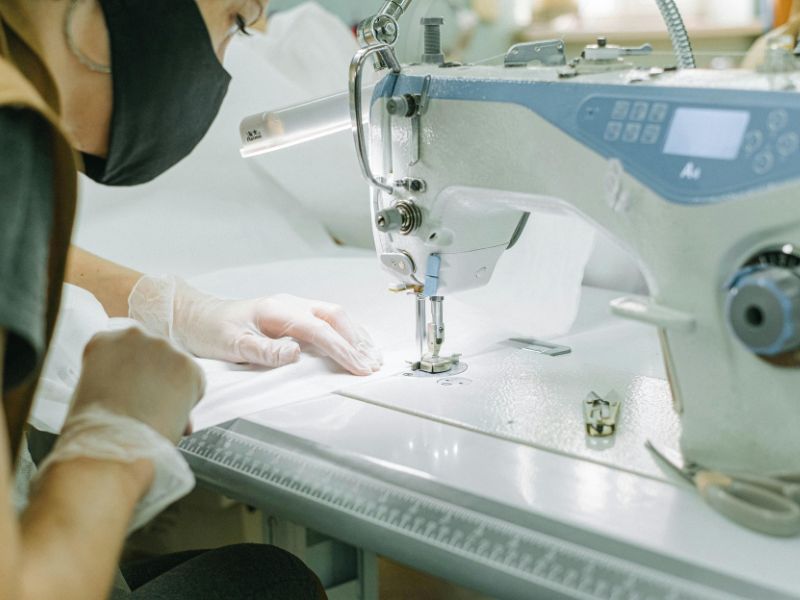
3. Align on Production Plans
This step is all about making sure you and your supplier are on the same page before bulk production begins. Let’s focus on:
- Make sure the measurements are clear and that the tolerance is agreed upon. Size range in Vietnam can differ from sourcing destinations like the US, EU, or Japan. For example, Vietnam’s L often equals US M or EU S. This is even more important when you are sourcing unisex items.
- Specify exactly what fabrics and colors you want, and the quality you expect, including approved lab dips. In Vietnam, quality is usually split into tiers such as Grade A (export quality), Grade B (domestic), and Grade C (factory seconds), so be specific with what you require.
- Provide easy-to-follow instructions or diagrams for cutting, sewing, and finishing. This is to avoid misinterpretation, reduce defects, and ensure consistent quality. (e.g. tech packs with flat sketches, operation sequences, stitch types etc.)
- Set a realistic timeline with buffer time for possible delays. For example, 60 days for production plus 7 extra days for customs clearance. Remember that factories often close around Tết (Vietnamese Lunar New Year) for 7-9 days plus some prep and ramp‑down time, so plan accordingly.
- Agree on when the prototype, fit sample, and pre-production sample should be approved.
4. Finalize Agreements and Keep Communication Clear
When you draft the sales contract, include a clear production schedule and spell out the Incoterms so both sides know who is responsible for shipping and delivery. List all product specs, fabric details, designs, and color samples. If you have physical samples, attach them to the contract and have the supplier sign and stamp them to avoid any confusion.
Payment terms also need to be put in writing. A safer approach is to release the final payment only after quality control checks are passed and textile lab tests come back clean.
How to Import Clothing from Vietnam: Essential Documents and Custom Clearances
Now let’s look at what it takes to move your products through customs smoothly so they can actually reach your customers.
1. Define Product Type and HS Code
HS Codes are numerical codes customs use to classify products anđ they dictate how much duty you owe and whether you qualify for FTA tariff benefits. In the category of Vietnamese clothing and apparel, the common international HS codes are HS 61 (Knitted or Crocheted Apparel) and HS 62 (Not Knitted / Woven Apparel).
Yet, the specific subheadings can expand and vary based on your product details, such as fabric type (knit or woven), material (cotton, synthetic, wool), and whether it’s for men, women, or kids. Each country also has its own version of HS code, oftentimes based on the first six digits of the international HS system.
Some quick examples under the US HTS of the Harmonized Tariff Schedule are as follows:
| # | Product Type | HTSUS Code | General Duty Rate (2025) |
| 1 | Men’s cotton jackets | 6203.32; 6201.30; 6211.32 | 20% |
| 2 | Women’s cotton jackets | 6204.32.2030; 6202.92.9061; 6211.42.1075 | 20% |
| 3 | Men’s cotton pants | 6203.42.4516 | 20% ad valorem |
| 4 | Women’s wool dresses or skirts | 6104.41.00.10; 6204.41.20.10; 6104.51.00; 6204.51.00.10 | 27-34% |
| 5 | Men’s silk shirts | 6205.90.1000; 6205.90.3050; 6105.90.4000 | 20% |
| 6 | Women’s cotton blouses | 6206.30.30; 6106.10.00 | 15.4 -19.7% |
| 7 | Men’s synthetic briefs | 6107.12.00; 6207.19.00.00 | Varies depending on the exact material composition |
2. Calculate Your Import Duties/Taxes
Taxes do not make up the total landed cost. You will also have freight, insurance, and customs fees to account for. Otherwise, your profit margin can shrink quickly. Import duties are typically calculated as such:
Import Duty = CIF value × Duty Rate + Any Extra Tariffs
In which:
- CIF value: Cost of goods + Insurance + Freight. It is the declared value on your shipment that U.S. Customs will use to calculate how much duty is due.
- Duty Rate: The rate based on the product’s HTSUS code, origin country, and any special tariffs applying.
- Extra Tariffs: Any additional duties that may be levied. At present, the U.S. levies a 20% reciprocal tariff on most goods imported from Vietnam, including clothing.
Imagine you are importing men’s silk shirts with a CIF value of 10,000 dollars. The HTSUS code for this product is 6105.90.40, with a regular duty rate of about 0.9 percent. With the extra tariff, the duty would be:
- Regular duty: 10,000 × 0.9% = 90 dollars
- Extra tariff: 10,000 × 20% = 2,000 dollars
- Total duty: 2,090 dollars

3. Prepare Import Documents
Like with any export, your shipment of clothing from Vietnam will need the right paperwork to clear customs. The list can vary a little depending on the product, so it helps to double-check with your freight forwarder or logistics partner before shipping. In most cases, you will be asked for:
- An import license
- A certificate of origin showing the goods are made in Vietnam
- A commercial invoice
- A packing list
- A bill of lading (for sea freight) or an air waybill (for air shipments)
- Product catalog or technical sheets, especially if the clothing is specialized (like protective workwear) or has extra requirements (like garments with functional coatings)
- Your business registration
These documents are typically required to be submitted at the customs office or port of entry in the destination country. Documents like the certificate of origin or commercial invoice can be requested from your supplier. Meanwhile, documents such as the import license or your business registration must be prepared by yourself and submitted in advance.
4. Comply with Destination Regulations
Besides the standard paperwork, most countries also have their own rules for labeling and product safety. Generally, your labels should include:
- The product name
- The country of origin, for example, “Made in Vietnam”
- The name and address of the manufacturer or importer
- The fabric composition with percentages of each fiber
- Basic care instructions
Some countries may require additional documents and labeling rules depending on their import rules. For example, in the US, you may need CBP Form 3461 (Entry/Immediate Delivery) or CBP Form 7501 (Entry Summary). Labels of clothing imported to the US must also be permanent and in English. They need to clearly show the washing, drying, and ironing instructions, and in some cases flammability warnings, especially for kids’ apparel according to the Flammable Fabrics Act (CPSC) and 16 C.F.R. Part 1610 / Part 1615‑1616 for children’s sleepwear.
In case you are importing clothing to EU countries, textile labeling is covered by Regulation No 1007/2011. You’ll need to state clearly if the item contains leather or fur. In addition to that is to provide REACH compliance documents and fiber composition test reports. Make sure to review all document requirements carefully to avoid rejection or shipment detention.
The following table represents the clothing labelling rules by country:
| Country | Permanent Label Required | Language Requirement | Care Instructions Required | Fiber Composition Required | Country of Origin Required | Flammability Warning (Kidswear) |
| United States | ✅ | English | ✅ | ✅ | ✅ | ✅ (16 CFR Part 1615/1616) |
| European Union | ❌ (not always) | Local EU Language | ❌ (if no care label) | ✅ | ❌ (unless misleading) | ❌ |
| Japan | ✅ | Japanese | ✅ | ✅ | ✅ | ✅ (nightwear) |
| South Korea | ✅ | Korean | ✅ | ✅ | ✅ | ✅ |
| China | ✅ | Chinese | ✅ | ✅ | ✅ | ✅ |
5. Choose Shipping Method and Handle Customs Clearance
For small shipments under 150 kg, air freight can be faster and sometimes cheaper. In practice, though, most clothing exports are bigger than that, so sea freight usually works best when shipping garments or other textiles from Vietnam, like from Hai Phong or Saigon ports, to your destination.
Shipping insurance is usually not included automatically, so be sure to tell your freight forwarder that you want the shipment covered from the moment it leaves the factory until it reaches your final delivery point.
Dealing with paperwork and shipping can feel overwhelming, so working with a licensed customs broker can help ensure everything is filed correctly and avoid costly mistakes.
Other Considerations When Importing from Vietnam
A few key points to keep in mind when importing clothing from Vietnam:
- Pay attention to quality control and inspections. Hiring a local third-party quality inspector can help ensure your clothing meets your specifications, passes chemical tests, and reduces the risk of shipments being held at customs.
- Be aware of cultural and communication differences. Most suppliers confirm contracts by email, but day-to-day chats often happen on Zalo, which is like WhatsApp. Having an account makes staying in touch much easier.
- Understand logistics challenges. Ports can get busy and shipping costs can fluctuate, so plan ahead for possible delays and include shipping fees in your budget.
VinaSources: Your Trusted Partner to Import Clothing from Vietnam
VinaSources is a leading Vietnam-focused B2B platform that helps you easily find verified clothing and textile manufacturers. We go beyond simply connecting you with suppliers and supporting you at every step, from sourcing and quality checks to shipping and compliance.
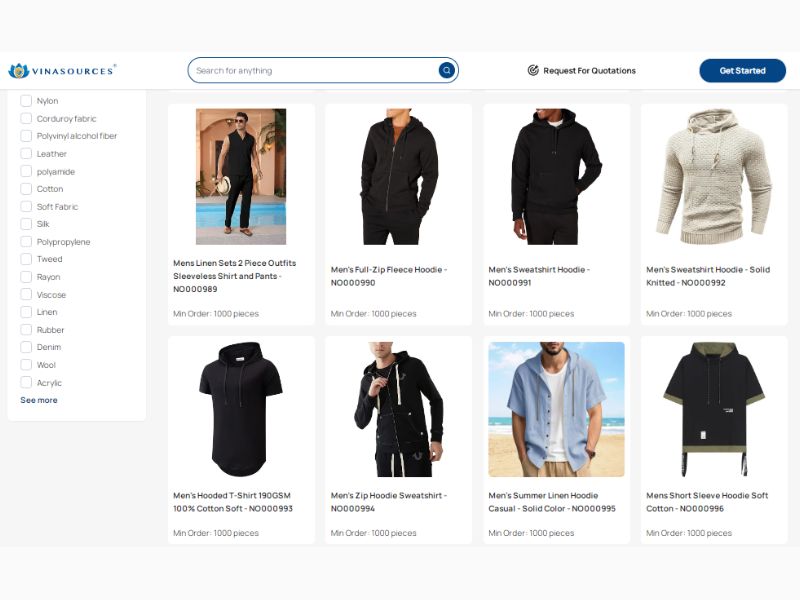
Currently, we feature hundreds of ready-to-export products across categories like casualwear, sportswear, uniforms, and knitwear. You can browse by product type, such as women’s apparel or men’s apparel, or filter by materials.
Send your request for quotes today and quickly receive verified offers from multiple local suppliers.
